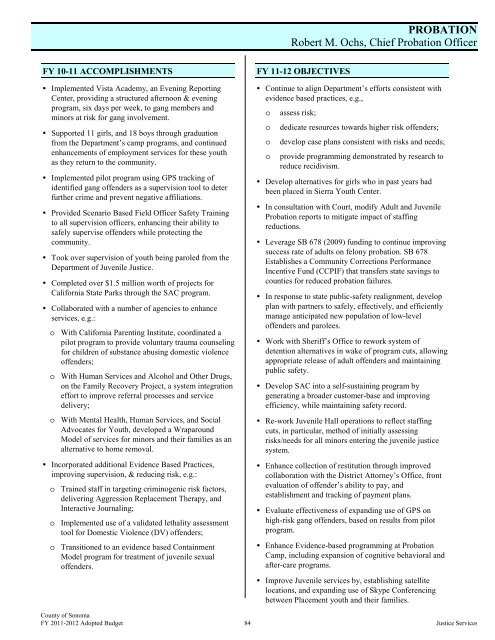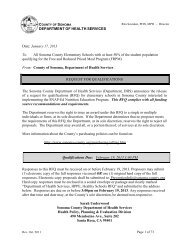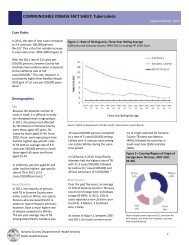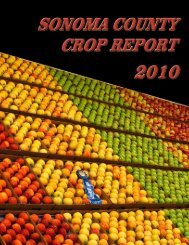Fiscal Year 2011-2012 Adopted Budget - County of Sonoma
Fiscal Year 2011-2012 Adopted Budget - County of Sonoma
Fiscal Year 2011-2012 Adopted Budget - County of Sonoma
You also want an ePaper? Increase the reach of your titles
YUMPU automatically turns print PDFs into web optimized ePapers that Google loves.
FY 10-11 ACCOMPLISHMENTS<br />
• Implemented Vista Academy, an Evening Reporting<br />
Center, providing a structured afternoon & evening<br />
program, six days per week, to gang members and<br />
minors at risk for gang involvement.<br />
• Supported 11 girls, and 18 boys through graduation<br />
from the Department’s camp programs, and continued<br />
enhancements <strong>of</strong> employment services for these youth<br />
as they return to the community.<br />
• Implemented pilot program using GPS tracking <strong>of</strong><br />
identified gang <strong>of</strong>fenders as a supervision tool to deter<br />
further crime and prevent negative affiliations.<br />
• Provided Scenario Based Field Officer Safety Training<br />
to all supervision <strong>of</strong>ficers, enhancing their ability to<br />
safely supervise <strong>of</strong>fenders while protecting the<br />
community.<br />
• Took over supervision <strong>of</strong> youth being paroled from the<br />
Department <strong>of</strong> Juvenile Justice.<br />
• Completed over $1.5 million worth <strong>of</strong> projects for<br />
California State Parks through the SAC program.<br />
• Collaborated with a number <strong>of</strong> agencies to enhance<br />
services, e.g.:<br />
o With California Parenting Institute, coordinated a<br />
pilot program to provide voluntary trauma counseling<br />
for children <strong>of</strong> substance abusing domestic violence<br />
<strong>of</strong>fenders;<br />
o With Human Services and Alcohol and Other Drugs,<br />
on the Family Recovery Project, a system integration<br />
effort to improve referral processes and service<br />
delivery;<br />
o With Mental Health, Human Services, and Social<br />
Advocates for Youth, developed a Wraparound<br />
Model <strong>of</strong> services for minors and their families as an<br />
alternative to home removal.<br />
• Incorporated additional Evidence Based Practices,<br />
improving supervision, & reducing risk, e.g.:<br />
o Trained staff in targeting criminogenic risk factors,<br />
delivering Aggression Replacement Therapy, and<br />
Interactive Journaling;<br />
o Implemented use <strong>of</strong> a validated lethality assessment<br />
tool for Domestic Violence (DV) <strong>of</strong>fenders;<br />
o Transitioned to an evidence based Containment<br />
Model program for treatment <strong>of</strong> juvenile sexual<br />
<strong>of</strong>fenders.<br />
<strong>County</strong> <strong>of</strong> <strong>Sonoma</strong><br />
FY <strong>2011</strong>-<strong>2012</strong> <strong>Adopted</strong> <strong>Budget</strong><br />
84<br />
PROBATION<br />
Robert M. Ochs, Chief Probation Officer<br />
FY 11-12 OBJECTIVES<br />
• Continue to align Department’s efforts consistent with<br />
evidence based practices, e.g.,<br />
o assess risk;<br />
o dedicate resources towards higher risk <strong>of</strong>fenders;<br />
o develop case plans consistent with risks and needs;<br />
o provide programming demonstrated by research to<br />
reduce recidivism.<br />
• Develop alternatives for girls who in past years had<br />
been placed in Sierra Youth Center.<br />
• In consultation with Court, modify Adult and Juvenile<br />
Probation reports to mitigate impact <strong>of</strong> staffing<br />
reductions.<br />
• Leverage SB 678 (2009) funding to continue improving<br />
success rate <strong>of</strong> adults on felony probation. SB 678<br />
Establishes a Community Corrections Performance<br />
Incentive Fund (CCPIF) that transfers state savings to<br />
counties for reduced probation failures.<br />
• In response to state public-safety realignment, develop<br />
plan with partners to safely, effectively, and efficiently<br />
manage anticipated new population <strong>of</strong> low-level<br />
<strong>of</strong>fenders and parolees.<br />
• Work with Sheriff’s Office to rework system <strong>of</strong><br />
detention alternatives in wake <strong>of</strong> program cuts, allowing<br />
appropriate release <strong>of</strong> adult <strong>of</strong>fenders and maintaining<br />
public safety.<br />
• Develop SAC into a self-sustaining program by<br />
generating a broader customer-base and improving<br />
efficiency, while maintaining safety record.<br />
• Re-work Juvenile Hall operations to reflect staffing<br />
cuts, in particular, method <strong>of</strong> initially assessing<br />
risks/needs for all minors entering the juvenile justice<br />
system.<br />
• Enhance collection <strong>of</strong> restitution through improved<br />
collaboration with the District Attorney’s Office, front<br />
evaluation <strong>of</strong> <strong>of</strong>fender’s ability to pay, and<br />
establishment and tracking <strong>of</strong> payment plans.<br />
• Evaluate effectiveness <strong>of</strong> expanding use <strong>of</strong> GPS on<br />
high-risk gang <strong>of</strong>fenders, based on results from pilot<br />
program.<br />
• Enhance Evidence-based programming at Probation<br />
Camp, including expansion <strong>of</strong> cognitive behavioral and<br />
after-care programs.<br />
• Improve Juvenile services by, establishing satellite<br />
locations, and expanding use <strong>of</strong> Skype Conferencing<br />
between Placement youth and their families.<br />
Justice Services

















